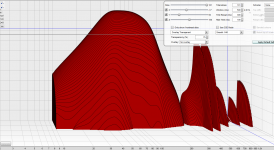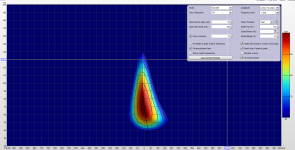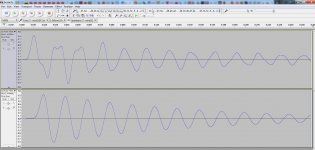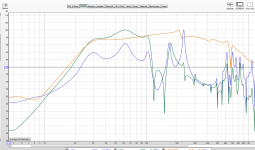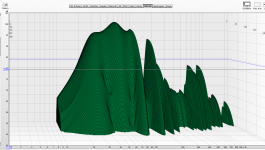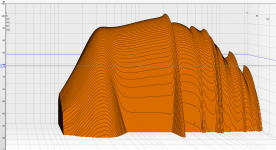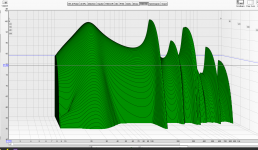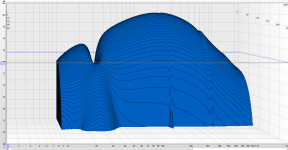I believe you are talking about the phase shift of BR at the tuning frequency. Nothing, an all-pass cannot correct.there will always be a lag in the port response.
I believe you are talking about the phase shift of BR at the tuning frequency. Nothing, an all-pass cannot correct.
How do you imagine to correct that independent from the driver?
At tuning freq there is hardly any contribution from the driver.How do you imagine to correct that independent from the driver?
At tuning freq there is hardly any contribution from the driver.
Agree. Consider 50.000 cycles.
What if drum plays at 59 ? See my simulation.
What I meant is: The total phase response of the BR (driver+port) rotates to 180 degrees at tuning, as belowAgree. Consider 50.000 cycles.
What if drum plays at 59 ? See my simulation.

If that rotation is corrected by a complementing all-pass then we dont have to bother about how much the driver contributes and how much the port.
The system phase is restored.
The system phase is restored.
I wonder if anyone looked at my simulation 🙄
Whatever. You all do what you want. I go fishing...

If that rotation is corrected by a complementing all-pass then we dont have to bother about how much the driver contributes and how much the port.
The system phase is restored.
Hi, how does that work exactly? What all-pass filter (freq, and order) would you use in this example? thx
I wonder if anyone looked at my simulation 🙄
Whatever. You all do what you want. I go fishing...
Be assured, i looked at it, and will look closer at home. I don't have access to your images at work, but seen it fast on my mobile screen.
I'll export some hornresp impulse (neither closed or BR) to play this way too with REW.
Thanks for sharing this way of analysing, it is exactly what lacked in our exchange, and thanks for sharing REW wavelet parameters screen too.
Hornresp impulse + REW is fun 🙂
Here a DFCBPCB without any stuffing ( Alias for : "Dual Front Chamber BandPass Closed Back"
Alias for : "Dual Front Chamber BandPass Closed Back"  )
)
Here a DFCBPCB without any stuffing (
 Alias for : "Dual Front Chamber BandPass Closed Back"
Alias for : "Dual Front Chamber BandPass Closed Back"  )
)Attachments
Last edited:
I wonder if anyone looked at my simulation 🙄
Whatever. You all do what you want. I go fishing...
Hi Joshcpct, I looked 🙂 and appreciate your work.
But i have to admit, I couldn't glean exactly what point(s) you were making.
Can you illuminate a bit? thx!
I couldn't glean exactly what point(s) you were making
Hi mark. Thx for appreciation

My point was, is the sum of driver and port real minphase?
I know each element is, but together?
Many smarties claim they can correct the phase of BR, by inverse-allpass using FIR DSP.
Phase correction and all good??
If the port plays later than the driver, and both play by the same signal driven, how do you change timing for that "combo" ???
To me, you can either have the driver in phase with the music, or the port, or the average. And average is what most do.
Understand? One input signal, two output incidents happening. Click in, Click Clack out. How to change time of click-in ???
So instead of using a hilbert transform to create an impulse and phase according to the frequency response - that will always look beautiful - I simulated a real complex time combination of an individual port and driver. And that complex impulse was being analyzed.
In comparison to one driver having same response without port.
And result is, port and driver have a drift. They have an "excess phase distortion".
Even with FIR DSP phase correction, it remains about 2ms longer to reach steady state and 2ms longer decay.
That may be little. On the limit of audibility. But its imperfection. Once the room is on studio level, it may become audible.
Notice this is also a "best case setup". Very clean and port directly on the cone. No offset.
No upper harmonics, MF tunnel resonance, breathing noise / air turbulence, unlinearity considered.
cheers
Josh
Last edited:
Just to add. Hornresp allow to simulate "perfect speaker" as constant velocity, to show only effect of enclosure. It's fun, i just start. But the more fun is to so feed this into REW !Hi, how does that work exactly? What all-pass filter (freq, and order) would you use in this example? thx
Just to play...In figure 1 : ROAR in green as it is simed. In purple, speaker as constant velocity to show drivers damping.
Figure 2: Roar waterfall
Figure 3 : a 15tbx100 Bass-reflex (port+driver)
Figure 4 : port only
Figure 5 : direct radiator only
Look at figure 4/5 around 30hz. This is what we are talking when way talk about out of phase. No matter if it's out of phase if there's such a difference in level. Look then at the resultant in figure 3. Not that much a big deal. At least, not worst than Roar.
Of course, it all need filters/Eq... that was just a enthousiat pretext tp inject hornresp impulse in REW
 .
.Attachments
Hi mark. Thx for appreciation
My point was, is the sum of driver and port real minphase?
I know each element is, but together?
Many smarties claim they can correct the phase of BR, by inverse-allpass using FIR DSP.
Phase correction and all good??
If the port plays later than the driver, and both play by the same signal driven, how do you change timing for that "combo" ???
To me, you can either have the driver in phase with the music, or the port, or the average. And average is what most do.
Understand? One input signal, two output incidents happening. Click in, Click Clack out. How to change time of click-in ???
So instead of using a hilbert transform to create an impulse and phase according to the frequency response - that will always look beautiful - I simulated a real complex time combination of an individual port and driver. And that complex impulse was being analyzed.
In comparison to one driver having same response without port.
And result is, port and driver have a drift. They have an "excess phase distortion".
Even with FIR DSP phase correction, it remains about 2ms longer to reach steady state and 2ms longer decay.
That may be little. On the limit of audibility. But its imperfection. Once the room is on studio level, it may become audible.
Notice this is also a "best case setup". Very clean and port directly on the cone. No offset.
No upper harmonics, MF tunnel resonance, breathing noise / air turbulence, unlinearity considered.
cheers
Josh
Hi Josh, thanks for the nice explanation.
Yes, i totally get that once we sum two acoustic sources together from different locations, we are no longer minimum phase.
And that ideally we would like to be able to correct the direct radiation of the driver, and the port independently.
(I advocate using FIR driver-by-driver on multiways quite often, and avoiding using global speaker correction unless using full-range drivers.)
But I don't think it matters much that we can't dsp the driver and port independently in a sub, because there is little difference between their phase curves where they sum.
I think the 2ms difference (70 vs 68ms) you showed in your sims what was throwing me.
Personally, I couldn't see that as significant and thought maybe there was more going on. But who know, maybe it is ????
Hi Mark
I agree. The difference isnt huge.
The drift that remains though phase was corrected, is small.
No correction of phase however is already something.
And difference to closed cabinet is quiet significant then. Mainly due to 2nd order. While ported is 4th order.
cheers
Josh
I agree. The difference isnt huge.
The drift that remains though phase was corrected, is small.
No correction of phase however is already something.
And difference to closed cabinet is quiet significant then. Mainly due to 2nd order. While ported is 4th order.
cheers
Josh
There are no transients in a signal that's low pass filtered. Take that kick drum sound and filter it as if it was going in to a sub then look at the waveform. The first transient peak will be gone! This is math.
Did not know that and sure enough, looked it up and it’s not just a little difference it’s almost all of the transient peak.
This explains why I lost my ‘thwack’ when I put a low pass on the woofers of my Burhoe (previously none).
So what exactly causes it? The inductor?
Also would biamping with dsp alleviate that?
Bob
The "thwack" is made up of higher frequency components. An inductor's impedance increases with frequency
The "thwack" is made up of higher frequency components. An inductor's impedance increases with frequency
So then dsp would alleviate the issue?
Ok well looking at it closer the thwack is from 1.5khz on up 3k with some saying even 5k.
Seeing as I crossed at 2k I’m thinking that had more to with it and dsp would not help that,
But I’m fairly certain dsp might bring back the initial sound or ‘bite’ even on the kick because that all went away also, in fact the whole bottom end went ‘blah’ after the low pass was initiated. So I guess the question should be would dsp instead of passive xo bring back the transients?
Is the subs active crossover on the amp knocking out these transient peaks also (the analog low pass knobs)?
Seeing as I crossed at 2k I’m thinking that had more to with it and dsp would not help that,
But I’m fairly certain dsp might bring back the initial sound or ‘bite’ even on the kick because that all went away also, in fact the whole bottom end went ‘blah’ after the low pass was initiated. So I guess the question should be would dsp instead of passive xo bring back the transients?
Is the subs active crossover on the amp knocking out these transient peaks also (the analog low pass knobs)?
Last edited:
- Status
- Not open for further replies.
- Home
- Loudspeakers
- Subwoofers
- Ported sub with good transient response
